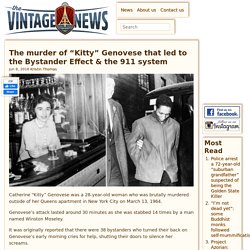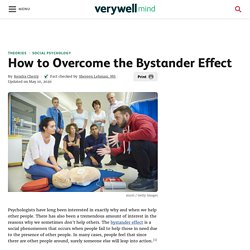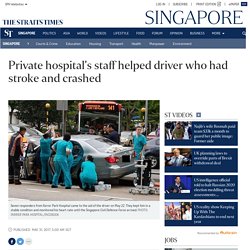

The murder of Kitty Genovese in 1964 has resulted in social psychologists focusing on bystander intervention problem (refer to video below), which discovered that the bigger the group on site, the slower the response and might even lead to total inaction, which is link to the science of empathy (refer to video below). The murder of "Kitty" Genovese that led to the Bystander Effect & the 911 system. Catherine “Kitty” Genovese was a 28-year-old woman who was brutally murdered outside of her Queens apartment in New York City on March 13, 1964.

Genovese’s attack lasted around 30 minutes as she was stabbed 14 times by a man named Winston Moseley. It was originally reported that there were 38 bystanders who turned their back on Genovese’s early morning cries for help, shutting their doors to silence her screams. Although that judgment was later proven to be inaccurate, the murder was considered the driving force behind our emergency 911 system today and the discovery of the term that so many psychologists are still researching: “The Bystander Effect.” It was around 3 o’clock in the morning when Genovese arrived home from managing a local bar where she worked. Kitty Genovese She parked her car and started walking towards her apartment building, when she noticed a man standing at the corner end of the parking lot. Genovese nervously kept walking. Studio photo of Catherine “Kitty” Genovese, 28. A Summary of the Bystander Effect: Historical Development and Relevance in the Digital Age.
The Science of Empathy. Diffusion of responsibility. How Diffusion of Responsibility Affects People. Diffusion of responsibility is a psychological phenomenon in which people are less likely to take action when in the presence of a large group of people.1 For example, imagine that you are in a large city on a bustling street.

You notice a man fall to the ground and start convulsing as if having a seizure. Many people turn and look at the man, but no one moves to help or call for medical assistance. Why? Because there are so many people present, no one person feels pressured to respond. U.S toddler ran over and left to die. Pluralistic Ignorance. What Is the Bystander Effect, Traits of Bystanders & Counteracting Bystander Effect. Are We Victims Of "Bystander Effect"? Chinese toddler run over twice after being left on street. Overcome bystander effect. How to Overcome the Bystander Effect. Psychologists have long been interested in exactly why and when we help other people.

There has also been a tremendous amount of interest in the reasons why we sometimes don't help others. The bystander effect is a social phenomenon that occurs when people fail to help those in need due to the presence of other people. In many cases, people feel that since there are other people around, surely someone else will leap into action.1 While the bystander effect can have a negative impact on prosocial behavior, altruism and heroism, researchers have identified a number of different factors that can help people overcome this tendency and increase the likelihood that they will engage in helping behaviors.2 Some of these include: Witnessing Helping Behavior Sometimes just seeing other people doing something kind or helpful makes us more willing to help others.
Imagine that you are walking into a large department store. Being Observant Being Skilled and Knowledgeable Guilt Feeling Good. Passersby rescue man pinned under lorry at Boon Keng Road ... Factors that reduce bystander effect. BYSTANDER INTERVENTION. Private hospital's staff helped driver who had stroke and ... A driver was given a fighting chance by a contingent of doctors and nurses after he had a stroke and crashed his car in front of Farrer Park Hospital (FPH) last week.

Nurse Steve Mocsoy was knocking off at about 5.30pm on May 22 when he saw the victim's battered Toyota in Race Course Road. A female passenger was apparently unhurt. Mr Mocsoy activated "Code Pink", the hospital's internal telephone number for responding to medical emergencies in its vicinity. Seven responders, including two doctors, reached the scene within five minutes, said the hospital. They kept the driver in a stable condition and monitored his heart rate with an electrocardiogram until the Singapore Civil Defence Force (SCDF) arrived. Bus driver beaten up by commuter for enforcing mask rule ... For 12 minutes on Tuesday, an SBS Transit bus driver was berated and then beaten up by a passenger who boarded the bus without wearing a mask.
SBS Transit detailed the assault in a Facebook post yesterday, saying that it happened at about 2.45pm, when a 52-year-old male commuter boarded service 21 at Pasir Ris Drive 6 without a mask. The man, who put on his mask only later, hurled vulgarities at the 39-year-old bus driver, and this continued for the duration of two bus stops. The Bystander Effect vs. The Good Samaritan Effect. More bystanders responding to CPR incidents thanks to 3 public health interventions: Study, Singapore News.
SINGAPORE - A study has found that three measures, when applied together, have more than doubled the likelihood of bystanders performing cardiopulmonary resuscitation (CPR) on cardiac arrest victims in Singapore. Dispatch-assisted CPR, CPR and automated external defibrillator training, and the Singapore Civil Defence Force's myResponder app were found to have increased the responses of bystanders giving life-saving assistance to heart attack victims before paramedics attended to them. Dispatch-assisted CPR refers to CPR that is administered under the guidance of a first responder, such as a paramedic who may, through a phone call, assess the situation and give instructions to a bystander, who then performs CPR. The study was conducted by researchers at the Duke-NUS Medical School, Duke University, and several organisations here, and published in August. The likelihood of a victim's survival also increased more than threefold, compared with no intervention, when all three aids were adopted.
Five steps for overcoming the “bystander effect” Source: Youtube (Active bystander)